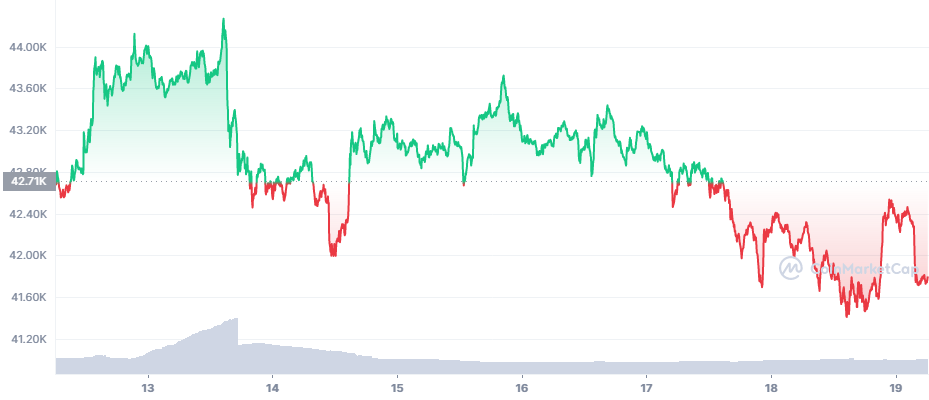Bitcoin (BTC) Depresses Market on Fear Sentiment

Bitcoin (BTC) crashed under $42,000, after holding relatively stable for the past few days. Altcoins lost up to 8% of their value on rapid sliding, based on their more volatile trading profile. BTC slid to $41, 748.03, once again accelerating its slide after a period of relative stability.
BTC slid after days of fearful sentiment, with no relief rally coming. Mid-month, BTC also saw weakening trading volumes at $23B in 24 hours. The BTC market cap dominance established itself around 39.9%. BTC continues to move sideways, with some fears of a bear market extending the losses. The Crypto Fear and Greed Index remains around 24 points or “extreme fear”, still up from its bottom around 9 points in early January.
For others, the current price slide may be temporary and actually lead to a breakout and short squeeze, for unexpected gains.
At the same time, data shows BTC open interest is relatively low, with not enough positions available to be targeted for a move in either direction. BTC ran hot in 2021, and for some, the possibility arises of a longer period of stagnant prices, or a more significant correction.
BTC is now closer to support levels that may break and lead to lower prices. In the past, death cross scenarios have seen BTC come out unscathed and move up on its own logic. The current slide may also turn into a bear trap and see BTC regain lost positions.
The current trading conditions happen with only a small increase in Tether (USDT) printing, with 78.3B tokens available for trading.
USD Coin (USDC) however, has added more than 13B new tokens in the past three months, injecting liquidity into most markets as one of the highly influential stablecoins to compete with USDT.
Can Ethereum (ETH) Survive the Sell-Off
ETH returned to around $3,100, erasing 3.5% of its value on diminishing trading volumes of $13B. ETH corrected to $3,135.79 after spending several days above the $3,300 mark and showing signs of regaining higher levels.
The most recent sell-off affected the value locked in DeFi, both as nominal value and in terms of liquidations and assets held for passive income. But the sector recovers fast, still holding more than $95B locked in vaults, trading pairs, and staking mechanisms.
However, ETH loses its market dominance, seeing it slide to 18.9% from previous highs of around 20.1%.
The ETH burn continues to decrease network inflation, destroying a notional value of $4.84B, or a little above 1.5M ETH since August 2021. Another 8.5M are locked for staking, thus making a significant dent in the available supply of ETH.
Can Altcoins Move Independently
In the past bull market, altcoins showed they could move independently, retaining most of the value gained and not returning to their previous prices. This made the latest crop of altcoins different from the altcoins in 2017, which mostly erased their short-term gains during the bull market rally.
Solana (SOL) sank to around $137, still lining up among top coins. The more recent hype lifted Cardano (ADA) to $1.50, but with questions whether the short-term hype could prevent a subsequent crash.
Tokens have more distinct groupings in 2022, forming trends in DeFi-related assets and play-to-earn games.
The collection of play to earn tokens, which ran hot at the end of 2021, lost $8B of its notional value within weeks, and now has a market capitalization of around $22B.
DeFi tokens kept most of their value at around $157B, but are also on a downward trend. The overall cryptocurrency market failed to cross the $3 trillion valuation barrier and sank back under $2 trillion, levels seen last in October 2021.
Are Altcoins Signaling Bear Market
Based on altcoin behavior, there are some signs the current price slide may be a mid-cycle correction and not a bear market comparable to the one starting in early 2018.
With more liquidity available and new types of blockchain usage, altcoins will also behave differently.
At the same time, most assets are down more than 60% from their peak. For some coins and tokens, such as Axie Infinity (AXS), peak prices coincided with peak interest in their game platforms.
Highly successful assets also showed they could easily lose half their value and there is still no tool to determine fair value. But projects like Solana, Terra (LUNA), and Avalanche (AVAX) help keep the value within the crypto market, with fewer opportunities for direct selling and incentives to hold coins and tokens for passive income.

Uphold makes buying crypto with popular currencies like USD, EUR and GBP very simple with its convenient options to swap between crypto, fiat, equities, and precious metals.

With over 50 coins and an obsession with security, Kraken is one of the safest places to buy and trade crypto.

Kraken has a good reputation for security and protection of your funds and operates across the USA (except NY), Canada, the EU and Japan

Based in Charleston, South Carolina. Serves over 184 countries and has done over $4 billion in transactions. Offers convenient options to swap between crypto, fiat, equities, and precious metals.

From Airdrop to Wallet we look at all the crypto jargon and what it really means

Learn how to keep your crypto secure and the different types of wallets you can use.

An innovative digital asset utilizing a fully decentralized consensus protocol called Ourobouros. The network aims to compete with Ethereum in offering smart contract functionalities. However it is lightyears behind Ethereum in terms of adoption.

This is a specific digital coin running on a series of servers. XRP promises utility in handling cross-border transactions to compete with the SWIFT interbank payment system. Being controlled by banks, many question if it is a true cryptocurrency.